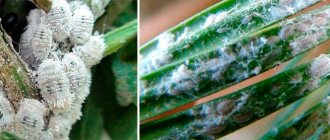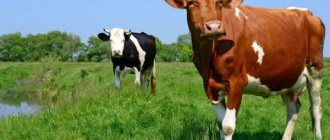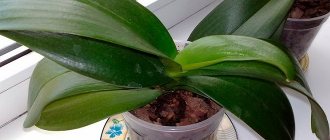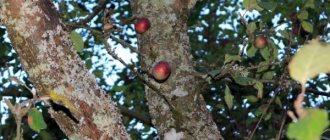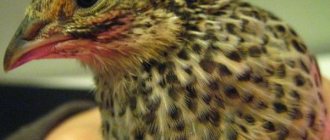Breeding rabbits is considered very profitable from the point of view of their high fertility, rapid growth and high cost of rabbit meat. They are often very peaceful and friendly animals. However, there are cases when the cruelty of the eared ones is simply amazing. If a female rabbit ate baby rabbits, this confuses many novice farmers, although cannibalism in long-eared rabbits is a fairly common occurrence. The causes and methods of dealing with the problem are described below.
Maternal instinct in female rabbits
A few days before the birth of the young, the female begins to prepare for this event by collecting suitable material from which the nest will be made. These are particles of hay, straw, leaves from branch food, and fluff plucked from oneself. At the moment the baby rabbits are born, a caring mother bites their umbilical cord and also helps them free themselves from the amniotic sac.
Some farmers become concerned if the female is indifferent to her rabbits during the daytime. But such worries are in vain: obeying instinct, the mother tries to attract as little attention as possible from strangers to the nest where the children are.
Rabbit with offspring
To reassure, the owner can carefully look into the house and make sure that everything is in order inside. Baby rabbits should be in the nest and fast asleep. This behavior indicates their satiety. Hungry young animals crawl around the nest and squeak restlessly. These animals have wrinkled skin on their bellies. Well-fed rabbits have smooth skin, without folds in the tummy area, and the babies spend most of their time sleeping.
Artificial feeding of baby rabbits by age
At each age, rabbits require their own feeding schedule.
The frequency is adjusted to the speed of food digestion. Appetite increases with the growing body. By the end of the first week, babies are already capable of overeating, so following the norms is necessary for their health. Until day 30, the diet consists only of milk. Up to a month, the diet includes only milk
From birth to 5 days
A newly born rabbit is given literally 1 drop of liquid. Over the course of a day, the number of drops is gradually increased in 5-6 passes.
The animal does not yet have a good swallowing reflex, so special care is needed. From the second day it is enough to feed 4-5 times. By the end of the period, the baby should double its birth weight (120-180 g for different breeds)
On the fifth day, food is given 4 times
By the end of the period, the baby should double its birth weight (120-180 g for different breeds). On the fifth day, food is given 4 times.
Pipette feeding
From 6 to 14 days
From 6 days, rabbits are transferred to three feedings a day. This regimen lasts up to 2 weeks of life. During this time, the weight of the babies reaches 200-260 g. Portions gradually grow along with the animals.
Syringe nipple
From 15 to 30 days
On days 15 and 16, individuals are transferred to a two-time diet. Observe their behavior, if there is not enough food, add a little mixture in the form of a third feeding. From day 17 onwards, portions become impressive, the body prepares for the adult regime, so do not exceed two feedings. By day 30, rabbits weigh about 500 g. Depending on the breed, the weight may be slightly less or more. Weaning from the pacifier begins at the end of the third week. Early ripening species are often ready for the introduction of other products already on the 20-25th day. You can track readiness by the behavior and condition of your teeth. When baby teeth are almost completely replaced by molars, interest in solid food awakens, and the animal is switched to a new food.
Baby rabbit drinks milk from a bottle
As they grow, the amount of milk increases. The larger the breed, the larger the single serving.
| Feeding rate per 1 individual per day (for 1 feeding) | |
| 1-7 days | 5 ml (1 ml) |
| 8-14 days | 20 ml (5 ml) |
| 15-20 days | 20-26 ml (10 -13 ml) |
| 21-30 days | 30-50 ml (15-25 ml) |
Why can a female eat her offspring?
The first thing after giving birth is that the mother rabbit licks and feeds the young. But it also happens that the female partially or completely eats the offspring. There may be several reasons, here are the main ones:
- There is not enough water in the cell. After giving birth, the female needs drinking water to quench her thirst, and in large quantities. If there is not enough liquid, then the female rabbit begins to eat the offspring and thus quenches her own thirst.
- Avitaminosis. During the prenatal period, female rabbits should be provided with a complete diet that will satisfy all the body’s needs for vitamin and mineral complexes. Poor nutrition leads to the fact that the female replenishes nutrients by eating the offspring.
- Poor diet and lack of feed after birth. The mother rabbit will not be able to feed her cubs if she does not receive food in the right quantity. Lack of food leads to the destruction of all or some part of the offspring a few days after birth.
- The birth of weak or stillborn rabbits. If such animals have no chance of survival (or are already born dead), then the rabbit eats them. This is a manifestation of innate instinct.
- Stressful situation. The rabbit is an animal with increased sensitivity, and therefore some primiparous females experience severe shock after childbirth and, out of inexperience, eat the baby rabbits in order to destroy their smell in their own nest.
- Heavy births. Sometimes (very rarely) the birth process may involve some complications, then the mother rabbit will help the babies leave the birth canal by using her teeth and pulling them out into the light. Such assistance often ends in the absence of limbs or ears in young animals.
Worth knowing. There are females who eat their first litter, and then don’t do this anymore and become excellent mothers. But if the situation repeats, this female rabbit must be culled from the reproductive herd.
How to prevent eating baby rabbits
If it was not possible to find out the reasons why the female rabbit eats the rabbits , then there is only one solution - the female is simply not allowed to reproduce and is sent for culling. If the rabbit breeder has identified factors that negatively affect the animal’s abnormal behavior, they need to be eliminated as much as possible:
- Move the rabbit to a quiet environment, away from noise.
- Look into the nest as little as possible.
- Inspect the queen cell only using rubber gloves.
- Protect the rabbitry from predators.
- Do not make a sudden change of environment (especially before lambing).
- Don't change your diet.
- Establish proper feeding in sufficient quantities, provide the animal with a full range of vitamins.
- Avoid interruptions in drinking water supply.
- Help the female set up a nest before giving birth.
- Do not change the litter in the first week after birth.
You should not rush to send a female to slaughter if she had to give birth for the first time. Due to her inexperience, she could simply take care of the babies incorrectly. Insufficient experience is indicated by a gnawed belly, when the mother has gnawed the umbilical cord incorrectly, or a gnawed baby's head, when it has incorrectly removed the amniotic sac.
Refusal of female rabbits from young animals
Some mothers ignore their children who try to remind her of their existence by squeaking. The rabbit goes to the far corner of the cage and pretends that she doesn’t hear anything.
The manifestation of this behavior is typical for primiparous rabbits, for whom childbirth is a strong stress and a sharp change in the usual life cycle. Before giving birth, the female can be transplanted into a larger cage with conditions different from the old ones. If the owner frequently inspects the nesting house, the female may begin to perceive it as a threat to her life. In the presence of extraneous sounds, the female rabbit becomes completely lost and begins to ignore her offspring.
Breastfeeding young animals when the female rabbit refuses
Being in a stressful situation, the female will refuse to care for the rabbits; the feeling of fear will completely drown out the maternal instinct.
Problems with milk production can also become a reason for abandonment of offspring. Here the female rabbit can act in two ways: simply not notice the young or eliminate the cause of the discomfort by eating the young.
If you refuse to feed your rabbits, you need to figure out the reasons for the situation as soon as possible and take measures to correct them, otherwise the litter will die.
Daily change of bedding and constant intervention of the farmer in the life of the female can lead to the fact that she simply stops caring for the offspring. Performing this function is possible only in a calm and familiar environment, and therefore the owner is not recommended to disturb the animal and newborn young without special reasons.
Attitude of the female rabbit to the litter
According to some rabbit owners, female parents are not very caring.
Rabbits provide attention to their offspring no more than twice a day. And the duration of each such contact does not exceed 5 minutes
It is also likely that both of these episodes will occur at night, as this is when rabbits are at their peak activity.
As a result, during daytime observation it begins to seem that the female rabbit has abandoned her brood, but this behavior is due to her instinctive desire not to attract the attention of predators to the offspring. But in some cases, the mother’s abandonment of her children is not at all fictitious.
So why do mother rabbits eat baby rabbits? This may be due to physiological reasons (lack of milk) or be a consequence of stress (accompanied by miscarriages or the birth of sick offspring)
But in some cases, the mother’s abandonment of her children is not at all fictitious. So why do mother rabbits eat baby rabbits? This may be due to physiological reasons (lack of milk) or be a consequence of stress (accompanied by miscarriages or the birth of sick offspring).
Sometimes, immediately after giving birth, the female rabbit finds herself under the influence of a strong sexual “hunt”. It is possible that the female will decide to give birth away from the nest (it happens that there is no special place prepared for the young) and will trample the newborns, not allowing them to eat. Most often, a mother rabbit eats her babies during her first pregnancies.
After these precautions have been taken, the babies are returned to their mothers, but their condition is monitored for another 2-3 days. In the first days, babies are weak, helpless and exposed to all dangers.
In the first days, babies are weak, helpless and exposed to all dangers.
Mother aggression in the animal kingdom is motivated by the need to protect her young. However, sometimes this aggression is misdirected.
Eating or killing one's own offspring is justified
The influence of provoking factors (sharp sounds or actions) forces the mother to rush to the rabbits, and this often ends in murder by negligence, when the rabbit crushes the rabbits with the weight of her body
If the nest is poorly prepared, the young are at risk of death from hypothermia. Rabbit breeders prefer to breed several females at once, so that if one of them has no milk, the babies can be transferred to another.
The female tramples her offspring: what is the reason
Some breeders are faced with a different problem: an adult female tramples the rabbits. She can run around the perimeter of the nesting house and not pay any attention to the fact that she is trampling on her children. In addition, the female rabbit refuses to feed the offspring, can scatter the little rabbits throughout the cage, and display aggression and restless behavior.
Baby rabbits in the nest
Here the reason may be that the individual came into heat immediately after giving birth. Inappropriate behavior is the result of hormonal imbalance and a sharp release of hormones into the circulatory system. In this case, the female must be covered as soon as possible before she completely harms her children. After mating, the female rabbit begins to behave much calmer, and her maternal instinct awakens.
Why does a mother rabbit throw her babies around and crush them?
A female rabbit may scatter newborn rabbits and begin to crush them as a result of the unfavorable influence of external factors:
- Poor rabbitry and poor conditions (crowded, dirty, cold or hot).
- The absence of a nest or its incomplete arrangement.
- When the female instinctively feels that the brood is incompetent and will not survive.
- Inexperience of firstborns.
- Breast mastitis.
- Milk deficiency and lack thereof.
- Resumption of sexual hunting.
If the problem is in the psyche of a long-eared woman in labor, then there is only one way out - slaughter.
Rabbit breeders should take into account that if there is noise or a lot of people gathering near the rabbit’s house, then the animal experiences stress and also throws the rabbits out of the nest.
If, for a number of reasons, the mother rabbit had to give birth to her babies not in the nest, but on the bottom of the rabbitry, then it is worth intervening and transferring the newborns to the nest. After all, without the warmth of their mother's down, they will very quickly die from hypothermia.
How to deal with problems
Of course, the above behavior of female rabbits causes damage to rabbit farming. To avoid losses or minimize them, it is worth understanding ways to prevent the situations described above. Details in the following table:
| Problem name | Causes | Solutions |
| Eating offspring | Lack of water, vitamin deficiency, poor quality feeding, stillbirth, weak offspring, stress, difficult birth | Monitoring the amount of water in drinking bowls, providing a complete diet before and after childbirth |
| Scattering baby rabbits | Inexperience of the female rabbit associated with the first birth, transfer to a new cage, lack of a nesting house, coming into heat, lack of milk, mastitis, the presence of a foreign odor (the owner took the rabbits in his hands), stressful situations, stillbirth | Inspecting the nest to identify stillborn rabbits and their removal from the cage, examining the female rabbit for her health and the possible appearance of mastitis. If detected, urgent treatment is required* |
| Trampling the offspring | Insufficient space in the cage, coming into heat, stressful situation, lack of a nesting house | Selecting a cage of sufficient size, installing a nesting house, covering the female, eliminating stressful situations |
*mastitis is detected by the presence of an enlarged nipple, redness, hardness, pain during examination and purulent discharge.
Reasons for eating
And yet, when a novice rabbit breeder believes that he has created optimal conditions for the long-eared mother and her babies, the female can commit her “bloody deed.” Why does an adult female eat her babies? This can happen due to various factors, each of which needs to be analyzed in great detail:
The animal's body signals a lack of water. The female rabbit lacks vital substances that she cannot get from the food offered by her owner. The first-born female takes care of the rabbits with great zeal, but, seeing only a drop of blood on his body, she begins to bite him, and then commits her terrible “deed.” If some of the rabbits are born already dead, the adult animal eats them for fear that the smell of decomposition of small corpses will attract the attention of predatory animals. When a large number of eared fluffies are born (more than 8), the female can eat several of them to give the rest of the rabbits adequate nutrition. The female rabbit may have problems producing milk. It accumulates, the nipples become rough, dry, and painful
When touching them, the female experiences unpleasant sensations. Then she perceives the rabbits as little tormentors and can also deal with them at any moment.
There are actually quite a few reasons for eating little rabbits. In each individual case, you need to carefully observe the mother rabbit and her cubs, see how, why and how her behavior changes, and how the cubs feel. If disturbing moments are not ignored, there will certainly be an explanation for the carnivorous tendencies of an adult animal. When it is clarified why the female destroys her own cubs, this phenomenon can be prevented in the future.
How to properly arrange a nesting house
A few days before the birth, it is necessary to install a special box in the cage, which will act as a nest, where the birth will occur. The bottom is lined with straw or hay in sufficient quantity. As a rule, females also add their own down for insulation. If for some reason the rabbit did not do this, then such work is assigned to the farmer.
Queen cell for the rabbit
It is strictly forbidden to pick up young animals that have just been born, otherwise the rabbits will acquire an alien odor, which can provoke aggression from the female. If it is necessary to examine the babies, you need to wear gloves, and in order for the mother to accept them, the rabbits should be rubbed with the female's down.
Instead of fluff, wormwood can be used: the smell of this herb drowns out everything else.
What to do if the rabbits have already been eaten?
There is no need to panic. There is an opinion that if a female rabbit eats her own rabbits, then she is subject to culling and can no longer serve for further procreation. Her observation should be observed. It will help to analyze your own mistakes and eliminate them.
If the female is young and, especially, giving birth for the first time, then she should be given time to “correct.” If aggression towards one’s offspring has become an established feature of behavior, then one will have to send it to slaughter.
Refusal of the female from the cubs and harm to them: what to do?
The female’s refusal to give up her cubs is visible almost immediately: she throws the babies around, rushes about, and sometimes crushes them. In this case, the babies should be placed with another rabbit, and this should be done quickly and carefully. The mother who has abandoned her offspring is placed in another enclosure, and the rabbits are placed in the mother of a female who has recently given birth. In order for another rabbit to perceive refuseniks normally, you can treat the cubs and your own hands with wormwood. It is harmless to newborns and blocks human odor. After a few minutes, you need to check: if the female has not started scattering her babies, then the adoption was successful.
Sometimes the reason for refusal can be poor lactation in a rabbit. In this case, it is worth checking the female for mastitis. Breast massage can also help.
From all of the above, we can conclude: a female rabbit is capable of eating her rabbits for many reasons. It could be natural instincts, an unsuitable breeding site, or stress after childbirth. With proper preparation for the birthing process, the risk of eating the offspring is extremely low. It is also extremely important for humans to control the process of birth and feeding of rabbits. Rabbits are not carnivores and a female will not eat her offspring without reason.
What to do
Underfeeding is dangerous not only for the offspring, but also for the female rabbit. If she has a large amount of milk left, it burns out. In the future, this leads to a deterioration in its production and even to inflammation.
Transfer to another uterus
The most effective method of saving babies is to be placed with another nursing female. First, the “stepmother” should be taken away from the nest, and the adopted children should be cleared of bedding and fluff from their native nest, so that no foreign smell remains. Farmers also recommend wiping your hands with pine needles. After this, the babies are laid out between other people's rabbits in the middle of the litter and covered with down. It helps to rub the baby rabbits with sawdust from the litter of the foster female. The main thing is that the adopted children must be close in age to the “stepmother’s” cubs, otherwise the stronger babies will not allow them to feed. The age difference between the two offspring should not exceed 3-4 days.
Artificial feeding
Artificial feeding should be used in extreme cases. First you need to put the baby rabbits in a warm place, for example under a lamp.
You can replace rabbit milk with goat milk (it is similar in composition, although not as fatty). Artificial mixtures for rabbits (puppies, kittens) are also suitable - they contain all the necessary microelements and vitamins. In rural areas it is easier to find goat milk. It is better not to use cow's milk.
A syringe without a needle or a pipette for older rabbits is suitable as a pacifier for newborns.
At first, it is not recommended to pour milk directly into your mouth. Just lubricate the animal's face, the little rabbit will lick the milk itself. The baby must be held vertically. After a few feedings, the cub will already get used to the procedure and then the milk can be dropped directly into the mouth.
Newborn rabbits are fed two to five times a day. During this time, the cub consumes about 5 ml of milk. Thus, when feeding five times a day, pour in 1 ml.
Week-old rabbits are fed 10 ml per day. The dose is increased gradually, being careful not to overfeed the baby. Two-week-old offspring already drinks 15 ml per day.
Maintain hygiene when feeding: wipe any remaining milk from the face and body. There is also an important detail - small rabbits do not know how to empty themselves. The female rabbit helps them, licking them from the navel to the hind legs. Use a cotton pad to massage your baby in the same direction before each feeding.
For two-week-old rabbits, start giving grated carrots, fresh small grass or hay. Don't forget about drinking water. Bring baby rabbits to it to teach them to drink from a bowl.
By the age of one month, the rabbits are already eating adult food and there is no need for milk.
When instinct fails
Maternal instinct is a series of norms of behavior based on the desire to protect and preserve offspring. Thanks to this, animals are able to survive and reproduce in the wild. However, very often more than half of the offspring does not survive in natural conditions. That is why the frequency of birth is 4-5 times a year.
Why does maternal instinct disappear in females at home?
A common reason for this is the reduced risk of danger. A rabbit raised on a farm does not feel threatened by the outside world in the same way as in the wild, and therefore is less interested in protecting her young. There are other possible reasons for the loss of instinct:
- stress after childbirth, especially after the first;
- crowded, dirty or poorly equipped nest;
- too many people;
- foreign odors and loud sounds;
- bustling environment;
- presence of domestic predators (cats, dogs).
In any case, it is impossible to accurately determine the cause of the loss of maternal instinct. This happens individually for each individual, the answer to the question “what to do?” is also individual.
The female rabbit may stop feeding and destroy inferior individuals.
Sometimes the cub can be eaten if the female accidentally runs over it. This is also one of the primary instincts. The corpse of a baby rabbit can attract the smell of a predator to the nest. By the way, not only female rabbits can eat dead rabbits; sometimes rats or birds of prey do this.
In addition to the loss of maternal instinct, the reason for eating the offspring may be a lack of water. The animal's body becomes severely dehydrated during childbirth, so it is necessary to ensure that the pet has access to water during birth, otherwise the rabbit herself will look for a way to replenish the lack of fluid in the body, and the simplest solution will be to eat the baby rabbits.
Very often, female rabbits can harm their babies due to increased aggression. Its reason is the desire to protect the rabbits from possible danger. There is no need to touch the cubs and the female during feeding; it is important to surround them with a calm environment. The female rabbit must feel completely safe, otherwise she often rushes to the aid of the offspring and often crushes them. Sometimes female rabbits begin to eat babies if there are more than 6 of them in the litter. Such babies are usually weaker and the female considers them unfit for life.
